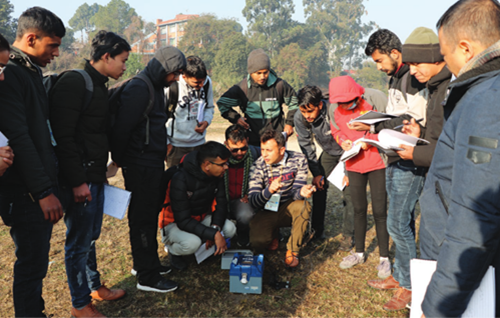How Geoscience Students Are Saving Lives Globally
Geoscientists Without Borders works with researchers and their students globally to help solve humanitarian crises.

In 2015, a magnitude 7.8 earthquake struck Nepal, killing nearly 9,000 people, including many in the nation’s capital city of Kathmandu.
Dr. Deepak Chamlagain, a geology professor at Tri-Chandra M. Campus, Tribhuvan University, believes that had building projects been guided by better data on seismic risk in the area, many lives would have been saved. As a result, Chamlagain now works with more than a dozen graduate students at his university to study seismic risk in the region.
These efforts are part of the Engineering Seismology and Seismic Microzonation for Seismic Site Effects Assessment program in Nepal, which is coordinated by Geoscientists Without Borders and part of that group’s larger Seismic Site Effects Study in Nepal.
Chamlagain and his students are using modern geophysical instrumentation to study subsurfaces in the region. This type of research seeks to identify ones that are good for building, such as bedrock, says geoscientist Dr. Bob Merrill, a member of the Geoscientists Without Borders committee, the Society of Exploration Geophysicists' humanitarian outreach program.
“If you build on other types of sediments, such as clay-rich sediments, or sands, these transmit the damaging seismic waves much more strongly than bedrock will,” says Merrill who is also president of Catheart Energy, Inc. “If you build in these areas, you have a whole new series of problems in terms of construction and the types of reinforcing that you need to do.”
Chamlagain says this type of data will help guide future construction. “We can say, ‘Okay this ground is good for pipes or building a multistory building,’” he says. “Our focus is on those cities which are rapidly urbanizing.”
Solving Problems Through Geoscience
Geoscientists Without Borders was started by geoscientist Craig Beasley in 2008 as an offshoot of the Society for Exploration Geophysicists. After the terrible devastation wrought by the 2004 Indian Ocean earthquake and tsunami, which killed more than 227,000, Beasley sought a way for geoscientists to share their expertise and potentially save lives from future disasters of this type.
Tools and ideas to transform education. Sign up below.
Merrill joined the organization because he was concerned with global humanitarian issues and was inspired by its solution- and student-centered approach. “As a geologist, I see many of these issues that can be mitigated or even solved by using our knowledge as geologists and geophysicists,” he says. “That can be having to do with earthquakes, tsunamis, landslides, identifying locations for water wells, even geochemistry of what's in the water that's being produced.”
The type of problems that can be solved with good geoscience are found in the developing world, but are also seen in the U.S., from water quality concerns to building practices that can leave communities vulnerable to flooding and other natural disasters. For example, in West Sumatra, Indonesia, Geoscientists Without Borders’ project partners evaluated the tsunami evacuation infrastructure in Padang, the province’s capital city, and developed a plan with local authorities, engineers, and others to improve evacuation plans in the region. In Nicaragua, project partners used geochemical analyses and social science to develop a better understanding of how persistent gas flux from the volcanoes at Masaya and Telica impact humans.
How to Work With Geoscientists Without Borders
Geoscientists Without Borders is currently involved in more than 50 projects with about 675 students, 80 university partners and 70 community partners. “About half of the projects that we’ve funded have to do with disaster preparedness, about half have to do with identifying locations for water wells,” Merrill says. “Then there's a smaller proportion that has to do with food security, such as using geoscience to optimize irrigation and agricultural fields and fishery [yield and sustainability].”
Geoscientists Without Borders’ requires that all projects must:
1. Provide funding to projects that will benefit communities in need where applying geoscience, technology, and information is critical to improving poor or potentially hazardous conditions.
2. Strengthen the global geoscience community through beneficial multidisciplinary partnerships and cooperation with other organizations active in engineering and geoscience.
3. Encourage students and introduce them to the broad range of geosciences careers while also strengthening university programs in geophysics and the geosciences.
Applicants include experts from around the world. “On many of our projects, the principal investigators are from U.S. universities,” Merrill says. “They've identified an issue, they often have partners, and international universities. Anyone can apply.”
In Nepal, Chamlagain says he is looking for international collaborators. “My message to the developed world is, ‘Let's work together in this field, and this could be the potential site for their research also,’” he says. “I always like to cooperate with different universities or research institutes abroad to focus on this kind of problem that we developing countries are facing.”
Erik Ofgang is a Tech & Learning contributor. A journalist, author and educator, his work has appeared in The New York Times, the Washington Post, the Smithsonian, The Atlantic, and Associated Press. He currently teaches at Western Connecticut State University’s MFA program. While a staff writer at Connecticut Magazine he won a Society of Professional Journalism Award for his education reporting. He is interested in how humans learn and how technology can make that more effective.

